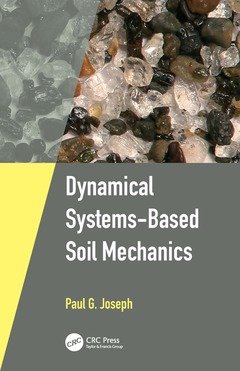Dynamical Systems-Based Soil Mechanics
Auteur : Joseph Paul

This book is a short yet rigorous course on a new paradigm in soil mechanics, one that holds that soil deformation occurs as a simple friction-based Poisson process in which soil particles move to their final position at random shear strains. It originates from work by Casagrande?s soil mechanics group at Harvard University that found that an aggregate of soil particles when sheared reaches a "steady-state" condition, a finding in line with the thermodynamics of dissipative systems. The book unpacks this new paradigm as it applies to soils. The theory explains fundamental, ubiquitous soil behaviors and relationships used in soils engineering daily thousands of times across the world, but whose material bases so far have been unknown. These include for example, why for one-dimensional consolidation, the e-log ? line is linear, and why C?/Cc is a constant for a given soil. The subtext of the book is that with this paradigm, the scientific method of trying to falsify hypotheses fully drives advances in the field, i.e., that soil mechanics now strictly qualifies as a science that, in turn, informs geotechnical engineering.
The audience for the book is senior undergraduates, graduate students, academics, and researchers as well as industry professionals, particularly geotechnical engineers. It will also be useful to structural engineers, highway engineers, military engineers, persons in the construction industry, as well as planetary scientists. Because its fundamental findings hold for any mass of particles like soils, the theory applies not just to soils, but also to powders, grains etc. so long as these are under pseudo-static (no inertial effects) conditions.
Introduction
Soil Shear–the Phenomenological Model
Soil Shear–the Physical Model (Part 1)
Soil Shear–The Physical Model (Part 2)
Soil Shear–Strain Rate (Viscosity) Effects
Consolidation Compression–The Generalized Model
Strain Rate (Viscosity)
Effects and Secondary Consolidation in One-Dimensional Loading
Finite Element Analysis Using DSSM
Conclusion
Appendices.
References
Paul graduated from a five year undergraduate in Civil Engineering at Engineering College, University of Madras, Madras, India in 1983. He then went on to graduate work in soil mechanics/geotechnical engineering at Purdue University, Indiana and after that, at the Massachusetts Institute of Technology, Massachusetts. He finished a Masters in Applied Mathematics at the University of Massachusetts (Lowell) in 2010, and in Fall 2013, obtained his Ph.D.Paul is registered Professional Engineer (PE) in the State of Massachusetts.
"Steady states are ubiquitous in nature and a mathematical framework (loosely called "dynamical systems theory") exists to describe systems with a steady state. The Great Red Spot on Jupiter is an example of a steady state generated by a dynamical system; mathematicians have extensively studied such dynamical systems. In 1971, Steve Poulos at Harvard first described the steady-state condition in soils. Based on this I was able to show that soil shear can be described as a "dynamical system" whose underlying basis is nothing but Poisson process based simple friction. These basic findings (steady-state, dynamical systems, Poisson process based simple friction) mark the advent of a new paradigm for describing soil deformation that is at once both simple and powerful. I call this new paradigm Dynamical Systems Soil Mechanics (DSSM for short). It is the only theory that predicts key relationships observed in the empirical evidence from decades of soil tests, relationships which hitherto, have simply been taken as "given.""
Date de parution : 04-2017
15.6x23.4 cm
Disponible chez l'éditeur (délai d'approvisionnement : 14 jours).
Prix indicatif 196,56 €
Ajouter au panierDate de parution : 04-2017
15.6x23.4 cm
Disponible chez l'éditeur (délai d'approvisionnement : 14 jours).
Prix indicatif 83,43 €
Ajouter au panierThème de Dynamical Systems-Based Soil Mechanics :
Mots-clés :
Tri-axial Tests; soil shear; Dynamical Systems Based Soil Mechanics; shear-strain rate; Interparticle Contact Area; thermodynamics; Random Shear Strains; soil deformation; Boston Blue Clay; poisson process; Incremental Loading Tests; Monotonic Shear Tests; Strain Rate Effects; True Triaxial Tests; Strain Rate Dependence; Secondary Consolidation; Primary Consolidation; Crs Test; Steady State Stresses; Steady State Position; FEA Program; Void Ratio Curve; FEA Date; Lotka Volterra Model; Steady State Line; Force Equilibrium Equation; CVR; NC; Cambridge University



